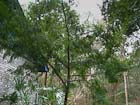Taxus floridana
Nuttall ex Chapman 1860
Common names
Florida yew (Hils 1993)..
Taxonomic notes
Syn: T. canadensis Linnaeus var. floridana (Nuttall ex Chapman) Pilger (Hils 1993). A study of the matK protein structure in nearly all species of Taxaceae and Cephalotaxaceae confirmed its close relationship to other species of Taxus (Hao et al. 2010), without resolving any further phylogenetic clues.
Description
Dioecious shrubs or small trees 2-5(-10) m tall and 38 cm dbh. Branches numerous, stout, spreading, forming an irregular crown. Bark purple-brown, first smooth, with age forming thin irregular scales. Branchlets round, ridged, at first orange, later becoming brown. Leaves pliable, dark green, 1-2.6(-2.9) cm × 1-2(-2.2) mm, slightly falcate, light green with 2 gray stomatal bands on the underside. Pollen cones formed along the shoots, yellow, solitary, 2-3 mm diameter. Seed cones formed on underside of shoots, a green fleshy aril maturing orange to red, each with a single exposed ellipsoid seed 5-6 mm long. Cone with seed ca. 2 cm long, 1 cm diameter, maturing in early fall" (Hils 1993, Sullivan 1993).
Distribution and Ecology
USA: Florida. Endemic to a small area of bluffs and ravines on the east bank of the Appalachicola River, typically in moist, shaded ravines in hardwood forests at 15-30 m elevation, where it occurs with the even rarer conifer Torreya taxifolia (Hils 1993). Several populations have been identified along a 24-km stretch of the river in Gadsden and Liberty counties. There is a single report of a stand in a Chamaecyparis thyoides swamp 13 km SE of Bristol, Florida (Kurz 1927), but it has not been verified in recent time. The ravines inhabited by Florida yew and Florida torreya are a rather unusual geomorphic feature.
Distribution data for all species native to the Americas, from Conifers of the World, downloaded on 2018.01.26.
Zone 9 (cold hardiness limit between -6.6°C and -1.1°C) (Bannister and Neuner 2001).
Florida yew grows in small, mostly clonal stands in forests dominated by Fagus grandifolia (American beech), Magnolia grandiflora (southern magnolia), Ilex opaca (American holly), and Quercus alba (white oak), in both open forest habitats and dense Kalmia latifolia (mountain-laurel) thickets (Sullivan 1993).
Birds consume almost of all ripe Florida yew cones. The relatively small distribution of this tree makes it unlikely that it is an important food source for any species. White-tailed deer rubs on Florida yew are common, sometimes causing extensive damage or death to the stem. Florida yew is a preferred food for beavers. Yellow-bellied sapsuckers excavate Florida yew for insects; holes characteristic of this bird were found on mature Florida yew stems (Sullivan 1993).
Remarkable Specimens
The largest is 22 cm dbh, 7.3 m tall, with a 6.7 m crown spread. It was healthy when last measured in 2014, and grows in Liberty, Florida (American Forests 2023).
Ethnobotany
No data as of 2024.01.17.
Observations
Due to the species' precarious status and the sensitivity of habitat in its very limited range, there are few places outside of arboreta where it is appropriate to observe it. The best is probably along the Garden of Eden trail in the Nature Conservancy's Apalachicola Bluffs and Ravines Preserve near Bristol, Florida. It also occurs in Torreya State Park.
Remarks
The epithet refers to the species' occurrence in Florida, where it is endemic.
Citations
American Forests 2023. 2021 National Register of Champion Trees, accessed 2023.02.22.
Chapman, A. W. 1860. Flora of the Southern United States. New York: Ivison Phinney & Co. P. 436.
Da Cheng Hao, Jun Mu, Shi Lin Chen, and Pei Gen Xiao. 2010. Physicochemical evolution and positive selection of the gymnosperm matK proteins. Journal of Genetics 89(1):81-89.
Kurz, Herman. 1927. A new and remarkable habitat for the endemic Florida yew. Torreya. 27:90-92.
Little, E. L. 1978. Atlas of United States Trees, volume 5, Florida. Washington, DC: U.S. Government Printing Office.
Sullivan, Janet. 1993. Taxus floridana. In: Fire Effects Information System, USDA Forest Service, Rocky Mountain Research Station, Fire Sciences Laboratory. http://www.fs.fed.us/database/feis/, accessed 2009.03.29.
See also
The species account at Threatened Conifers of the World.




